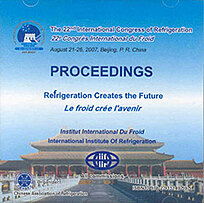
Document IIF
Prévisions d'émissions de R-134a basées sur l'identification d'un coefficient de diffusion de polymères utilisé dans les composants des systèmes de conditionnement d'air mobile.
R-134a emission previsions based on identification of diffusion coefficient of polymers used in mobile air-conditioning components.
Résumé
In Europe, mobile air conditioning (MAC) systems using R-134a will be tested as of 2007 in order to guarantee initial leak tightness, the annual emissions shall be lower than 40 g/year according to the Directive 2006/40/CE (EU, 2006). Leak tightness of almost all parts of MAC system is linked to the diffusion through polymeric materials (seals and hoses). Thus, permeation and diffusion of gas through these materials play a fundamental role in emission previsions. This paper focuses on mass transport mechanism of refrigerant through polymers and aims at identifying the permeation and diffusion coefficients of different types of materials. Simulation models for steady state and transient state, using finite element method, allows interpreting experimental results, and particularly for complex structures (hoses are multi-layer components). Based on experimental studies, a theoretical model is proposed to predict emissions of MAC hoses as a function of pressure and temperature.
Documents disponibles
Format PDF
Pages : ICR07-B1-1594
Disponible
Prix public
20 €
Prix membre*
Gratuit
* meilleur tarif applicable selon le type d'adhésion (voir le détail des avantages des adhésions individuelles et collectives)
Détails
- Titre original : R-134a emission previsions based on identification of diffusion coefficient of polymers used in mobile air-conditioning components.
- Identifiant de la fiche : 2008-0368
- Langues : Anglais
- Source : ICR 2007. Refrigeration Creates the Future. Proceedings of the 22nd IIR International Congress of Refrigeration.
- Date d'édition : 21/07/2007
Liens
Voir d'autres communications du même compte rendu (839)
Voir le compte rendu de la conférence
Indexation
- Thèmes : Conditionnement d'air mobile
- Mots-clés : Équipement frigorifique; R134a; Joint; Automobile; Modélisation; Matériau; Fuite; Conditionnement d'air
-
High efficiency and leak-tight future MAC systems.
- Auteurs : CLODIC D.
- Date : 23/10/2006
- Langues : Anglais
Voir la fiche
-
Flexible Kältemittelleitungen für CO2: Fahrzeug...
- Auteurs : BURKHARDT C., BALMER B.
- Date : 16/11/2005
- Langues : Allemand
- Source : DKV-Tagungsbericht 2005, Würzburg./ 2005 Proceedings of the DKV Conference, Würzburg.
Voir la fiche
-
Développement d'un système de conditionnement d...
- Auteurs : KOMATSU S., TSUNODA M., YAMAMOTO S.
- Date : 07/12/2000
- Langues : Japonais
- Source : The International Symposium on HCFC Alternative Refrigerants and Environmental Technology 2000: Latest technology for Energy Conservation, Refrigerants and Recycling on Air-Conditioning and Refrigeration Equipment for the 21st century. Proceedings.
Voir la fiche
-
Fuel-efficient, leaktight HFC-134a systems thro...
- Auteurs : FERNQVIST H.
- Date : 10/02/2003
- Langues : Anglais
- Source : MAC Summit 2003. Options to reduce greenhouse gas emissions due to mobile air conditioning [CD-ROM].
Voir la fiche
-
Optimization of R134a and CO2 refrigerant circu...
- Auteurs : HAGER J., ANZENBERGER T.
- Date : 20/06/2002
- Langues : Anglais
- Source : Mobile air conditioning. International IIR Workshop.
- Formats : PDF
Voir la fiche
